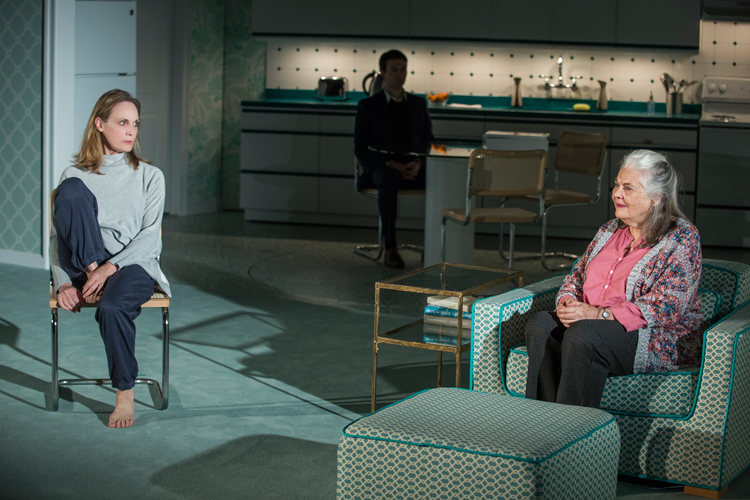
Bainbridge Island, where Jordan Harrison grew up, is rustic and lush, marked by winding two-lane roads that cut through sheets of gothic Pacific Northwest mist as they weave along an expanse of jagged, soaring coastline; in my experience, you’re about as likely to encounter a harbor seal there as you are a person. Just 10 miles across Puget Sound, close enough to be visible from the eastern beaches, is hi-tech Seattle, brimming with modernist architecture; birthplace of Microsoft and Nirvana; home of e-readers, coffee shop entrepreneurialism, the WTO riots, and eye-rolling hipsters. This image — two opposite worlds, negative spaces of one another, separated by a narrow passage — always comes to mind when thinking about Jordan’s plays, and it strikes me as a vantage point from which to enter his work. I imagine him in his melancholy formative years, passing between these worlds, gazing across the water, always awed by the view of the other side.
Though the form Marjorie Prime takes is a striking contrast to the rest of Jordan’s body of work to date, it shares their DNA. Each entry vividly imagines an alternate version of the world, one that’s just on the other side of this one, a playful wide-eyed hypothesis — a thought experiment that we’re invited into — the encounter revealing to us our own world in a fresh light.
Feature Photo: Noah Bean and Lois Smith. Credit: Jeremy Daniel, Playwrights Horizons.
Jordan made an auspicious debut in 2002 with Kid-Simple, a radio play in the flesh, a genre-bending action-fable in which a plucky teenage whiz-kid inventor named Moll journeys to a sultry fairytale forest “on the wrong side of the river.” On a quest to recover her miraculous invention, a machine for hearing sounds that can’t be heard, she’s whisked away from her cozy suburban life with her mom and dad, and opened up to a heretofore invisible world. In The Museum Play (2003), a young, broken-hearted curator installs his ex-boyfriend as an exhibit in a natural history museum, a desperate attempt to create an alternate reality with a better outcome. Jordan’s eerie thriller Finn in the Underworld (2004) centers on a young man whose sexual curiosity draws him down into his grandfather’s fallout shelter, where he’s transported into the heart of an unfinished ghost story buried deep in his family’s past.
“When you think you know how to see something but when you’re done you see it someway else.”
Each of these earlier plays whisks its characters into an imagined landscape that reveals a more complex understanding of the world they came from. Such is the case in the prohibition-era town of Act a Lady(2005), where a handful of men in a local community theater production dress up in “fancy-type women-type clothes.” As their tight-lipped Midwestern world becomes intertwined with the 19th-century French melodrama they’re rehearsing, each character we meet is forced to confront gender identity until the notion becomes as changeable as putting on a costume. “To me that’s art,” one character says at the end of this romp. “When you think you know how to see something but when you’re done you see it someway else.”
Taken individually, it’s hard to fathom how his plays could have come from the same writer; each new play is a totally unique, idiosyncratic landscape —a sharp and unexpected turn from everything else he’s written. But when looking at Jordan’s plays collectively, they reveal a writer with an ecstatic love for language whose characters seem to wear it like a carefully considered costume; a writer whose distrust of the future is betrayed only by his relentless pursuit to understand it, and who obsessively mines the past in hopes that it may reveal some kind of logic about the present; who’s preoccupied with words, with how they scan, how they form in the mouth, how they look on a page, and with the weight they hold when sitting in a room; whose approach to each subject he takes on, however adult the subject may be, seems to somehow carry a child’s sense of wonder and awe; who remembers to us the strangeness of our world by envisioning an alternate version of it.
In Jordan’s Amazons and Their Men (2006), an auteur film director reminiscent of Leni Riefenstahl fights to keep the real world at bay, but she can’t keep the love story on her sound stage safe from the burgeoning war outside. And his pop fairytale Doris to Darlene (2007) charts an unexpected course from girl groups of the 1960s back to the tormented 1860s Bavarian wünderland of Richard Wagner, and then forward to the lonely yearnings of a present-day teen: three far-apart worlds drawn onto the same map, searching into one another from their isolation. Futura (2009) extends the rapid digitization of today’s world into a cautionary vision of the not-so distant future, opening our eyes to what may be lost as we eradicate the printed word. And in Maple and Vine (2011), a present-day couple, lost amid the unbounded opportunities and choices in the contemporary city, joins a 1950s reenactionist society where their relationship to freedom and repression becomes richer, more complex, and unnervingly satisfying.
Feature Photo: Lois Smith, Lisa Emery and Stephen Root. Credit: Jeremy Daniel, Playwrights Horizons.
“It would have to be about a land where it never snows.”
Each of Jordan’s plays invites us to cross into another world, whether it’s wholly invented, an impressionistic vision of the past, or an imagined possibility for the future. But his ability to conjure worlds, as virtuosic and consistently stunning as it is, is less the point — to my mind, anyway — than his compulsion to do so. He works through the idiosyncratic, imagined landscape of each play to find what it might reveal to us about the one we live in. In a 2010 interview Jordan was asked, “If you were to write a play that took place in a snow globe, what would it be about?” To which he replied, “It would have to be about a land where it never snows.” Because we have to live in the world on a day-to-day basis, for better or worse, we inescapably become inured to it; we develop habits. And habit has a way of deadening our perceptions, keeping us from considering or questioning what surrounds us. The most essential nature of our hypothetical snow globe, and our automatic expectation for it, is the promise of snow. By altering the very thing that defines it, our perception of the snow globe reawakens, and it once again holds mystery. As Jordan’s plays call on imagined landscapes of the past or future, or as they defamiliarize the present, our habitual thinking is disrupted. “Art exists that one may recover the sensation of life,” Viktor Shklovsky famously wrote. “It exists to make one feel things, to make the stone stony. The purpose of art is to impart the sensation of things as they are perceived and not as they are known.” As Mister Everly in The Museum Play asks, “Do you remember learning how to look?”
Marjorie Prime is a surprise, an anomaly among Jordan’s plays. Set in the near-ish future, it centers on Marjorie, who at 86 years old is losing her grip on her memories and, by extension, her sense of self. Pitching a more concentrated emphasis on the confrontations and manipulations that pass between this family, this is formally the closest to realism we’ve seen from Jordan so far. But though Marjorie Prime may turn a corner stylistically, his hunger to invert the world, to see it with fresh, wide-open eyes, is insatiate. In the world of this play, Primes can help a grieving family cope with death by creating the illusion that it hasn’t happened. But though they strive to become more human, they’ll always lack the very essence of humanity: our mortality. And in the process, what it means to be human at all is the very question that’s left hanging.
Reprinted with permission from Playwrights Horizons.
To purchase a copy of Marjorie Prime, click here, and to learn more about licensing a production, click here.

Plays and Musicals Adapted from Novels

Play by Play: The Theatrical Works of Agatha Christie



